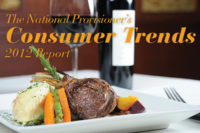Typically, consumer trends are driven by things like innovative restaurants and world travel. This year, the restaurants aren’t open, and many people haven’t traveled further than their front door, thanks to the restrictions that the Coronavirus pandemic have placed on our lives. Consequently, consumer trends have come from slightly different sources, but the meat industry still must adapt to what the consumer needs; and this year, they need some help.
At the onset of the pandemic, when consumers were first sheltering in place, comfort foods were among the go-to meals that they made. We are now some seven months into the pandemic, and the meals may be changing.
“As the pandemic continues, 54 percent of consumers are seeking out healthier types and cuts of meat and chicken,” says Michael Uetz, principal of Midan Marketing.
Midan has been tracking the impact the COVID-19 pandemic has had on consumers and how they purchase and consume meat and chicken products. Uetz says that household meat consumption is holding steady and Midan expects that to continue in 2021. The way that they find inspiration for new ideas and the way that they shop have changed.
“Consumers are continuously going online to find inspiration for cooking meat and poultry,” Uetz says. “Retailers and foodservice operators have the opportunity to creatively educate and entertain consumers on new ways to use meat cuts. As we continue to maneuver through these times, reaching consumers where they are most comfortable now will pay dividends after the pandemic is over, as they will feel a connection to those who inspired them.”
Ordering meat products online has also taken a major step forward. A recent Midan study showed that around 53 percent of consumers are ordering meat online. The majority of them are using a local grocery store or retail website app for pickup. The fact that shoppers are having positive experiences with online ordering should lead to a sizable portion of that audience to keep shopping online.
“In September, a third of consumers reported they were going to use an online service as their primary method to purchase protein after the pandemic, and this segment continues to grow. Consumers indicate they like the convenience of online grocery shopping and are pleased with the quality of fresh items chosen for them, suggesting that the barriers surrounding having others select meat products for them are diminishing,” Uetz says.

Michael Uetz
(Photo by Midan marketing)
Consumers have also increased the practice of freezing meat for future use, Uetz adds. The Midan Marketing COVID-19 research study from late September showed 55% of consumers plan to continue to freeze meat more often than normal in the upcoming months.
“As we look at how the pandemic has changed consumer shopping habits, it’s important to account for those who are freezing meat at a higher rate than pre-pandemic,” he says. “Freezing instructions and packaging that don’t require consumers to portion product into other containers will be important.”
The struggling foodservice sector
The foodservice industry has of course taken numerous hits during the pandemic. Some restaurants have been forced to close entirely, while others make do with reduced seating and to-go orders. Fast-food restaurants have fared the best, but sit-down restaurants reported more traffic in the summer months, as diners were able to sit on patios. The winter months may bring more trouble to the sector, as some states are placing further restrictions on restaurants as the COVID numbers rise.
Restaurants that operated this year typically did so with streamlined menus. Uetz says that the long pandemic is affecting what consumers order when they decide to eat out.
“Consumer feedback shows they miss the social experience of dining out, are tired of cooking at home and are bored with the meals they can prepare themselves. When consumers choose to spend their dollars at a restaurant, whether it’s dining out or delivery, they desire foods that are harder to make at home like steak, fried chicken or ethnic dishes,” he says.
Meat snacks stay strong
The meat snacks sector has been one of the most reliable sellers in the meat industry, as the number of flavors and types of snacks continued to increase.

Jon Senastiani
(Photo by Sonoma Brands)
KRAVE was one of the early brands that took the meat snack category in a premium direction. Founded by Jon Sebastiani, KRAVE gained enough recognition in the sector that it was acquired by Hershey in 2015. Sebastiani and his new business, Sonoma Brands, re-acquired KRAVE in April 2020. He also acquired the Chef’s Cut brand of meat products later in the year. He has seen the sector innovate and diversify very quickly.
“Our original focus in revolutionizing the jerky category was on bringing non-traditional high-quality ingredients and a culinary flavor profile to the space, which has since caught on with a wide swath of jerky brands,” he says. “When you look at jerky and meat snack products today, you see that premium brands with out-of-the-box flavor profiles, cleaner ingredient panels and improved textures are everywhere you turn — the premium jerky category is growing three times faster in the marketplace than regular jerky.”
The Coronavirus has presented some unique challenges to the meat snack market. The pandemic has limited the amount of traveling that people do, and one of the sector’s key customers was the out-and-about person looking for a quick protein fix.
“However, there have been big shifts in consumer buying habits - using online DTC channels more, buying large quantities of shelf-stable products during less frequent trips to the grocery store - that are forcing brands to pivot, ramp up production and find ways to keep stores stocked,” Sebastiani notes.
Adaptability is going to be an important characteristic for any meat company in 2021. Midan Marketing’s Uetz explains that as the future of the pandemic is unknown, processors must continuously be in contact with their customers to understand their needs and make necessary adjustments.
“During the initial phases of the COVID-19 pandemic, meat processors went above and beyond to incorporate additional health and safety measures to keep their employees healthy and safe. These measures will continue to be important to keep the industry moving forward and to gain consumer confidence,” he says. IP





Report Abusive Comment